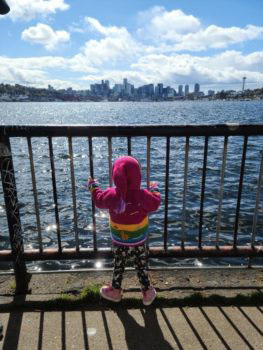‘I Can’t Wait to Swim!’: How a Kidney Transplant Changed the Possibilities for 4-Year-Old Stella
6.22.2022 | Ashley Speller
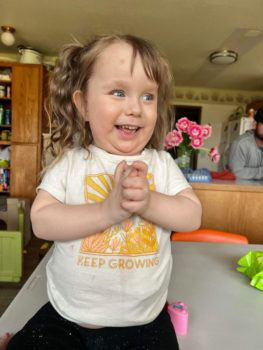 “She has so much more energy and is eating so much more. She is also moving and walking more than she ever did.”
“She has so much more energy and is eating so much more. She is also moving and walking more than she ever did.”
Four-year-old Stella Allison has always loved telling jokes and playing dress up.
With energy that is contagious and a smile that lights up a room, her mom Kyley Barthlow says Stella has grown into a high-spirited and chatty child – but was born a real fighter.
Early Signs of Kidney Disease
“Through ultrasounds, we realized her bones were curved and she had cysts in her kidneys. There were a lot of things that made her high risk,” Barthlow explained.
Dr. Sangeeta Hingorani, an attending physician in pediatric nephrology at Seattle Children’s and a professor of pediatrics conducted a pre-natal consult and observed in utero that Stella’s kidney’s looked bright and some of her limbs were short. Dr. Ian Glass, director of Medical Genetics at Children’s and the director of the Alaska Genetics and Birth Defects Program also met with the family.
Barthlow, who is from Blaine, WA, then made the arrangements to give birth in Seattle but because Stella had other plans and arrived early, she was born nearby in Bellingham.
“Her feet were turned and then post-partum, the nurses noticed that she was creating more urine than what was normal,” Barthlow said.
The Best, Complete Care for Stella
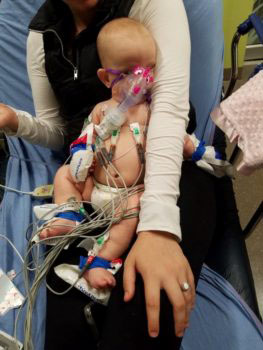 At just two days old, Stella was transferred via helicopter to receive specialized care from a team of experts in the Division of Nephrology at Seattle Children’s, who diagnose and care for babies, children and teens with kidney problems, including the most complex disorders, and have been recognized by U.S. News & World Report as one of the top 10 pediatric nephrology programs in the nation for over a decade.
At just two days old, Stella was transferred via helicopter to receive specialized care from a team of experts in the Division of Nephrology at Seattle Children’s, who diagnose and care for babies, children and teens with kidney problems, including the most complex disorders, and have been recognized by U.S. News & World Report as one of the top 10 pediatric nephrology programs in the nation for over a decade.
“We have a shared goal and mission. The physicians, advanced practitioners, clinic, dialysis, and transplant nurses all work together to support families and their kids living with kidney disease so they can reach their full potential, live their best lives and achieve their goals and dreams,” Hingorani said.
Stella’s impaired kidney function and bone abnormalities were identified as consistent with nephronophthisis and cranioectodermal dysplasia, also known as Sensenbrenner syndrome. At just four months old, Stella’s parents were told that Stella was also blind due to the impacts of Sensenbrenner on her eyes.
“She developed end-stage kidney disease at an early age and started peritoneal dialysis (PD) within her first year of life. This family has been really remarkable in their care for Stella and their support of her development with her blindness,” said Hingorani.
For over two years, Stella was able to continue her dialysis from home with the help of the PD team including ongoing guidance from Dr. Raj Munshi while she worked on gaining the necessary requirements needed for her next step of care.
The Search for a Kidney
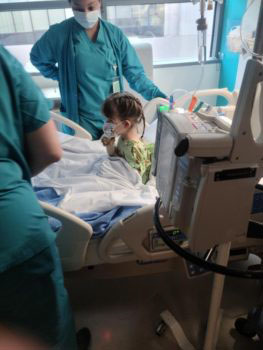 “When we start children on dialysis in infancy, a really important part of what we try to do is to get them the nutrition they need to grow and develop normally. Our dialysis patients are referred to transplant early to start to learn about that process, but they have to be a certain height and a weight to actually be able to sustain an adult size kidney within them,” Hingorani explained.
“When we start children on dialysis in infancy, a really important part of what we try to do is to get them the nutrition they need to grow and develop normally. Our dialysis patients are referred to transplant early to start to learn about that process, but they have to be a certain height and a weight to actually be able to sustain an adult size kidney within them,” Hingorani explained.
By the time Stella turned three years old, she was on the donor transplant list waiting for a match. Barthlow’s own family and friends signed up to help and ultimately participated in a successful paired exchange facilitated through the National Kidney Registry (NKR) and performed at Seattle Children’s Transplant Center by Dr. Patrick Healey, one of the few surgeons in the nation trained in both pediatric surgery and transplantation.
“It was such a big relief. Everybody had a moment where we just sat and were taking it in. Things are going to start to be normal,” Barthlow recalls.
New Possibilities Post-Transplant
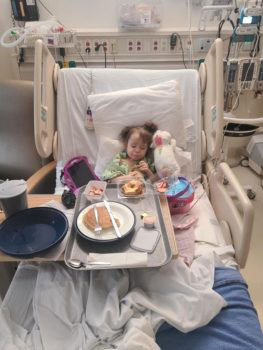 In the three months since the transplant, Stella, who one day wants to become a doctor or nurse, is active and thriving today.
In the three months since the transplant, Stella, who one day wants to become a doctor or nurse, is active and thriving today.
“My favorite color is blue, I love to play patty cake, clapping hands and most of all I can’t wait to swim!” she shared.
“Stella seems like a normal four-year-old. She has so much more energy and is eating so much more. She is also moving and walking more than she ever did, especially because walking came slower to her since she can’t see,” Barthlow said. “She is such a water baby and can’t wait to take swim lessons. You can’t get a PD catheter wet so this will be amazing.”
Hingorani also is noticing the improvement with every clinic visit.
“She’s a different kid after transplant. The goal is that these kids grow normally and live full productive lives with their kidney disease and their transplants. Stella’s much more interactive, alert, and articulate. There’s just a different brightness about her,” she added.
A Home Away From Home
Barthlow says it’s been rewarding to see her daughter finally able to do the things that she’s always wanted to do. She is also thankful for the people at Seattle Children’s who made what feels like a rollercoaster of a journey a little bit easier through care and compassion.
“It’s good to know that you are not alone and that the staff and other people in the community are there to help you. It’s very scary and very new,” she said.
“Everyone there was just so incredibly nice, and they would all light up when Stella walked in the room. They just they made it feel like home.”
